Can You Retarget On Kickstarter?
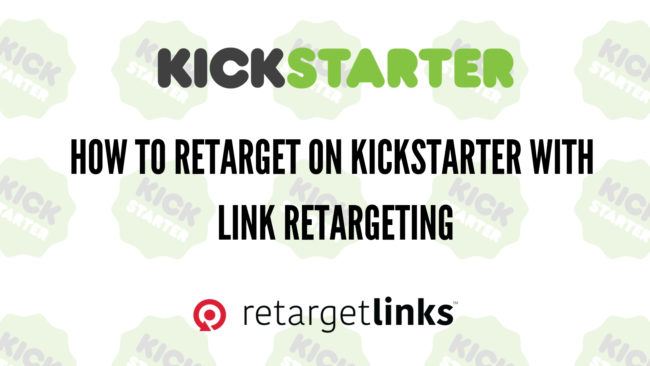
The answer to this question is simple. You can’t. However, as the CrunchCup team demonstrated, there is an elegant way-around to do retargeting that Kickstarter allows.
Kickstarter provides an incredible platform for entrepreneurs to assess product-market-fit for concept or idea before investing time and money into production. If enough people back the product then it is obvious that there is a need for the product and that’s when the product goes into production!
Why retarget on Kickstarter?
Because most people don’t kiss on the first date! Before backing a project, they are going to do some research, compare alternatives… think about it… and then forget it or simply consciously move onto something else.
Kickstarter campaigns suffer from the same issues as most e-commerce markers: 95% of your campaign page visitors will not back your project. This figure seems abysmally low but, as it is a more niche platform formed of crowdfunding enthusiasts willing to take some risk, the conversion to paying is still twice as high as found in traditional e-commerce.
Retargeting is a way for the campaigner to be able to keep the campaign top of mind by displaying ads to all those that visited the campaign page. With retargeting, about 15 ads are displayed to each user in high-authority websites such as Forbes, Cosmo, Elle, Wall Street Journal, Facebook and many others, for a period of usually 2-4 weeks following the first visit to the page.
Why does Kickstarter not allow retargeting?
We are not entirely sure but, as strange as it sounds for someone that believes so much in retargeting, it kind of makes sense for Kickstarter not to allow retargeting on their pages.
Before getting into the subject, we need be unveil some technical details. In order to retarget on a Kickstarter page, a campaigner must create a retargeting account on Google, AdRoll, Facebook or another provider and then insert a script of code onto the Kickstarter project page. This script of code drops an anonymous cookie to all traffic to this page.
Secondly, it is important to understand where the traffic, that will be retargeted, comes from. In big part, this is traffic that results from the campaigner’s promotion: email marketing, Facebook ads, AdWords etc.
Another large source of traffic that can be considerable, however, is the traffic sent by Kickstarter itself. Kickstarter, in fact, heavily promotes projects that are trending or projects that Kickstarter knows that a backer has affinity with. As you have noticed if you have backed a project, each update email from a campaigner advertises other campaigns at the bottom of the email. This is the same for every page in Kickstarter.
And here is where the problem lies – Retargeting that traffic will allow a campaigner to market their own homepage (outside of Kickstarter) or even the campaigner’s page on another crowdfunding platform. In a physical world, this would be akin to allowing someone to distribute flyers from BestBuy, inside Walmart. If you are Walmart, you will of course never allow this to happen.
So, how can you retarget on Kickstarter?
There is a source of traffic Kickstarter will not mind you to retarget and one that Kickstarter can’t do anything about: the traffic that you, yourself, send to your own Kickstarter page.
When you share your Kickstarter page with friends and family or when you promote it online via social media or email marketing, you can use link retargeting to retarget all the traffic to your Kickstarter page.
This is how CrunchCup did it. They were able to raise 95% more money that they initially intended on and retarget every user that clicked on a link to their Kickstarter page with RetargetLinks.
How CrunchCup implemented “Link” Retargeting
Here is how CrunchCup retargeted all the traffic they were sending to their Kickstarter page:
1) Retargeted everyone that they were in touch with: In order to start making some noise, the CrunchCup team reached out to their network initially to generate some organic traffic. They sent out emails to their friends and family and people they had in their network.
They also shared their concept via social media and redirected users to press articles that talked about them on Forbes, Digital Trends, Product Watch and more! You can check out their Forbes article (and be retargeted by their campaign – assuming it is still live) by clicking here: https://re.tc/forbes-crunch-cup
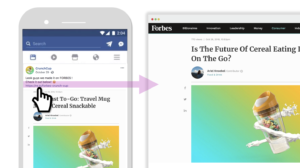
Every one that clicked on these links, on email or social media, were added to their retargeted audience that they could display ads to later on.
2) Retargeted via Facebook ads: Once they maximized earned and organic media, the team then ran a Facebook ad campaign. They targeted people who might be interested in cereal and cereal brands (users who liked the Kellogs Facebook page or had interacted with cereal related pages in the past). They also went broader and targeted users that had kids! Each user that clicked on the Facebook ad was automatically added to the retargeting audience in RetargetLinks.
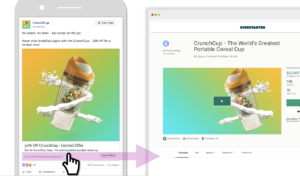
With RetargetLinks, CrunchCup was able to drop cookies on 86,916 unique users. This is a lot of people, like a medium sized town they can then show banner ads to. This is important as 95% of these visitors will not do any pledge and there is no way to reach them again except for displaying a dozen ads over the next 2 weeks.
3) Launched the ad campaign: CrunchCup then displayed almost 56,000 ads within the span of a week. Their ads were shown on high authority sites including Forbes, CNN, Vogue, Cosmopolitan and more. They also displayed ads in Facebook to be also present there.
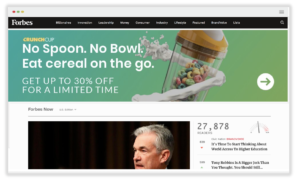
They had a click-through-rate of 0.23% (4X higher than industry average) and close to a 129 clicks on the ads which, including view-throughs (this is people that see the ads, don’t click on them but go to the website), they were able to bring 258 users back to the Kickstarter page. The results of the campaign can be seen below:
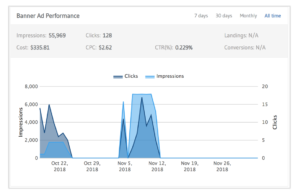
4) Saw incremental conversions from the campaign: Based on our experience, the link retargeting campaigns have a 25-33% conversion rate. As Kickstarter doesn’t allow any scripts to be added to their page, there is no sure way to know the exact number but since everything is higher in the crowdfunding world, we think it is safe to assume a 33% conversion ratio.
This means that 85 of the 258 users that clicked on the ads, ended pledging for the CrunchCup campaign. Since we don’t know what user pledged what amount, we calculated a range taking the minimum and average pledge.
Taking the average pledge of $60, we can safely assume that CrunchCup made up to $5,100 in pledges from their retargeting efforts. Since they spent only $335.81 in total, this yielded them a ROI of 15.2X. They made +15% in pledges on top of what they had made to date ($30,113).
5) What is next? Once the crowdfunding campaign is over, the campaigner can still leverage the existing cookies as they remain live for about 6 months.
Since they were able to tag 87,000 unique people clicking the links (and being cookied) and each user would have seen about 15 display ads, the CrunchCup team is able to display up to 1,250,000 ads in addition to the 56,000 that were already shown.
With their click-through-rate of 0.23% and save view-through rate, they would have directed almost 5,750 people over to their Kickstarter page. With a conversion rate of 33%, about 1,900 out of the 5,750 visitors would have completed a purchase after the campaign was over.
This would have yielded them up to $114,000 (vs the $5,100 they made to date) assuming the same $60 average purchase. The cost of displaying the ads at $8 CPM would be $10,000 over a period of 2-3 months.
Want to be our next success story?
If you’d like to see your story here, get started by shortening your first link!
Have questions on where we might fit into your strategy? Let’s chat.
